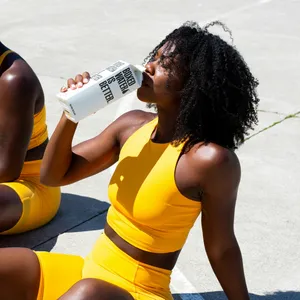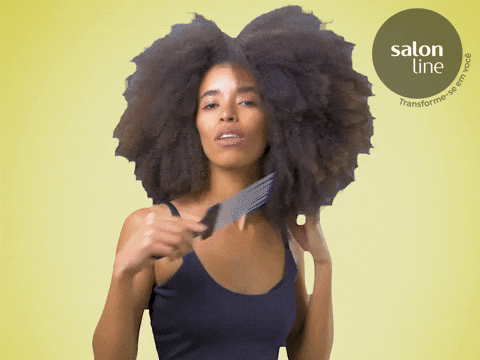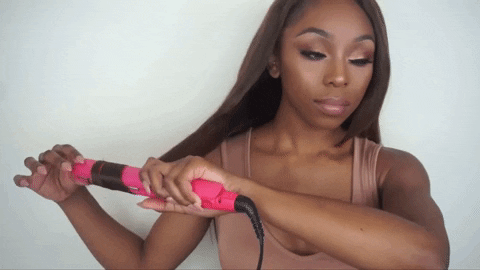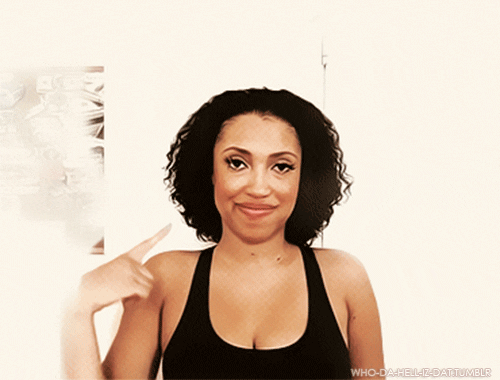
xoNecole's I Read It So You Don't Have To is a recurring series of self-discovery that breaks down self-help books into a toolkit of takeaways and tips that are meant to assist you in finding the best life you can live. Take what works for you, and leave everything else where it is.
At the beginning of the year, I knew I wanted to: 1) Prioritize myself and my dreams like never before and 2) Strive for authenticity in every aspect of my life. What I didn’t know was that in a few months, roadblocks would materialize, and old wounds would resurface. What started as well-meaning declarations slowly morphed into misguided attempts to chase after my dreams and show up for myself in the process. I felt overwhelmed by the unrealistic expectations I placed on myself and burnt out over balancing my responsibilities.
My belief in Jesus Christ is paramount and who I turn to first, especially when it comes to healing, but I’m also an advocate of therapy and utilizing positive resources that support my personal growth. I figured I’d try a resource that could complement my journey of inner work, provide insight into my personality, and remind me of the joy and peace that is within me.
So after ignoring the self-help and personal development aisle in the bookstore (I’m a fiction type of gal), I opted for Yasmine Cheyenne’s book The Sugar Jar: Create Boundaries, Embrace Self-Healing, and Enjoy the Sweet Things. As an educator, speaker, and mental-wellness advocate, Yasmine provides a thoughtful and impactful approach to healing and recognizing patterns in our lives that drain us.
Here are 7 takeaways from her book to embrace healing and practice self-care.
Care for Your 'Sugar Jar'
Cheyenne likens our body and mind to a jar. It represents who we are and how we present ourselves to the world. Within the jar is our sugar, or as she writes, “all the sweet parts of you.” It can be represented as our time, our energy reserved for the activities we care about the most, and our gifts/expertise. To prevent the sweetness in our lives from spilling out or from being given away frivolously, the lid on our jar serves as a boundary.
Caring for our jars, or our very essence, is more than placing them in a safe environment.
Through regular check-ins, we maintain the integrity of our jars. For instance, to recognize a sugar leak or a relationship/responsibility that drains our time and peace, we can pay closer attention to our needs and enforce boundaries to protect ourselves. We can change the size of our jars to hold more or less in our lives depending on the season we’re in. Most importantly, we can fill our jars by prioritizing self-care.
Prioritize Presence Over Performance
As a recovering people-pleaser, I often struggled with my desire to belong in spaces while showing up as my whole self. I would perform based on the expectations of those around me and find my worth in their praise of my performance. I would ignore red flags and pretend that I was okay to avoid having tough conversations. It was as if I wore a mask, shifting it in place or ditching it altogether, depending on who I was around. Performing in these ways drained me emotionally, physically, mentally, and spiritually.
Yasmine says that agreeing to perform is another way of saying, “I believe that who I am isn’t enough.” Instead of acting on the internalized belief that I have to be someone else to belong, I prioritized being fully present as my true self, even if it was uncomfortable.
I paid close attention to the suggestions presented in the book and began to:
- Recognize that it’s okay if I don’t fit in everywhere
- Acknowledge my emotions and desires even if it differs from those around me
- Cast imposter syndrome aside
- Refuse to downplay my successes
Know the Difference Between a Boundary and a Barrier
Boundary setting gets a bad rap. Often we view it as selfish or a way to bend others to our will lest they kiss a relationship with us goodbye. Cheyenne defines a boundary as “the rules or structures that we put in place that manage the way we interact with the people, places, things, and commitments that we have in our lives.” Boundaries help us communicate our needs and how we intend to show up in the world around us. They also keep us safe and protect our mental health. However, in an attempt to protect ourselves from experiencing pain, we sometimes build a barrier that ends up keeping good things from entering our lives.
For example, a boundary could be explaining your needs to a friend after feeling as though you aren’t a priority in their life. A barrier could be ending the friendship the moment you’re disappointed and swearing off getting close to others in an attempt to avoid future disappointment.
It can feel intimidating to set boundaries with people who might have constant access to you or even to set boundaries with yourself, but starting small is key. Here are a few tips to get you started:
- Say yes to opportunities that align with who you are and your beliefs
- Decline an invitation if you know you need to prioritize rest (or if you simply don’t want to attend)
- Ask yourself what you’re comfortable with and communicate it
Let Go
The Sugar Jar helped me realize that letting go is an act of self-care. For most of my life, I held onto perfectionism and the notion that I needed to earn my worth. I could understand when others fell short of my expectations, but I would mentally berate myself if I missed my mark. I didn’t give myself the space to make mistakes and was far too tough on myself. I came to realize that holding space for myself when I am less than perfect means that I am human. And most importantly, I recognized that even with my flaws, I am enough.
Letting go also meant releasing the version of myself I’d outgrown without guilt. There were iterations of myself that existed for specific seasons. One version existed when I was content with playing small and believed that I didn’t have what it took to achieve my dreams. Another version needed to be in control 100% of the time to feel safe. I found joy when I realized that I could appreciate who I used to be but realize that there’s no shame in evolving.
Lean Into Acceptance
I used to bypass the inner work I needed to complete in my life by focusing on others. I wore my ability to encourage and counsel those around me as a badge of honor and poured so much energy into watching them transform. It’s no wonder I would feel frustrated if they chose a different path or if they felt content operating in a way that I didn’t agree with. I learned that acceptance doesn’t mean tolerating poor behavior but meeting people where they are.
Once I learned that it’s not my responsibility to change anyone (especially a person that doesn’t believe a change is necessary), the pressure I once felt decreased. Leaning into acceptance meant I recognized that we all have different capacities and timelines for growth.
Simply put, once I started to accept others for who they were I started to focus on my growth.
Dismiss the Urge To Be the “Strong One”
As I mentioned earlier, I derived a lot of pride from pleasing others. Not only did I lack boundaries, but I also played into the societal pressure to be strong 24/7. After all, wouldn’t I be liked even more if I showed that I could handle any and everything? Wouldn’t I prove I’m a great wife, mother, friend, and daughter if I supported my loved ones at all costs? I was wrong. Even worse, I had embodied the Black Woman Trope even though I knew better.
I justified my actions because I pegged myself as the “strong friend,” the “reliable daughter,” or the “super mom.”
There’s nothing wrong with exhibiting strength and showing up for loved ones, but this book gently reminded me that even the “strong ones” need support too. Consider the following questions that were posed in the book if you’re fighting the urge to constantly show your strength:
- Does someone’s need for me help me feel stronger, validated, or necessary?
- How can I be strong and worthy of connection without fully supporting everyone else’s weight?
Gauge Your Healing
It would be easy to gauge our healing if it presented itself as a simple cut on the hand. We'd watch the blood begin to clot and the skin around the wound seals itself until nothing but a tiny scar remained. Unfortunately, there's no clear-cut path to healing from the wounds we cannot see. The good news is that we can assess our healing by checking in with our emotions and taking stock of the improvements we've made (big or small).
Cheyenne says, "Just because you've learned some tools, it doesn't mean you won't have fears, intrusive thoughts, or concerns about choosing the 'right' things for yourself." There are no magic pills to take and no finger snaps that can erase the negative feelings associated with healing. But we're aiming for progress, not perfection, as we heal. So, for example, if you've struggled with setting boundaries, you might see that you are healing when you finally communicate it. You might still feel nervous about the action, and it might not even come out as smoothly as you want it to the first time. You'll notice you're healing even more when you're able to communicate your boundary with ease and can enforce it.
Embracing the intricacies of our healing and shedding parts of ourselves that no longer serve us takes dedication and a lot of work. But even as we work towards being a better version of ourselves, we can still experience the sweetness the journey has to offer.
Let’s make things inbox official! Sign up for the xoNecole newsletter for daily love, wellness, career, and exclusive content delivered straight to your inbox.
Featured image by Catherine Falls Commercial/Getty Images
This Is How To Keep 'Holiday Season Stress' From Infecting Your Relationship
Hmph. Maybe it’s just me, but it seems like there is something really weird happening in the fall season air (because winter doesn’t officially begin until December 21) that cuddle season is in full swing while break-up season is as well. In fact, did you know that break-ups are so popular during the holiday season that December 11 is deemed Break-Up Day?
The reasons why relationships shift around this time vary; however, I did both roll my eyes and chuckle when I read that a very popular one is because it’s an easy way to get out of getting one’s significant other a Christmas present. SMDH.
Anyway, I personally think that the less shallow folks out here may contemplate calling things “quits” or they at least distance themselves a bit from their partner (and what I’m referring to is serious relationships) due to all of the stress and strain that oftentimes comes with the holidays whether it be financial, familial, due to their tight schedules or something else.
Listen, I would hate for you and your man to miss the fun and happiness of experiencing this time of year, all because you are so overwhelmed or irritated that you can’t really enjoy it. That’s why I have a few practical tips for how to avoid allowing the typical holiday season stress from INFECTING your relationship.
Manage Your Expectations
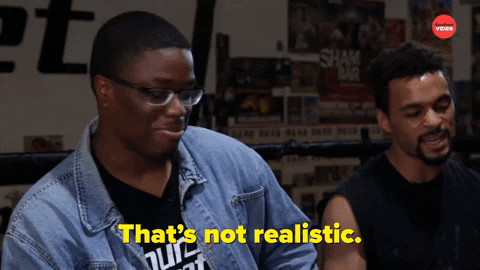 Giphy
GiphyUnmanaged expectations. If there is a main reason why the holiday season tends to be so stress-filled for so many people, I’d bet good money that this is the cause. And when you’re in a long-term relationship, expectations can manifest themselves in all sorts of cryptic and/or unexpected ways. You might have relatives who assume that you are going to be with them for Thanksgiving or Christmas when you have other plans in mind. You might be thinking that you are going to spend one amount for presents while your man is thinking something totally different. When it comes to scheduling, your signals may be crossed.
And you know what? To all of these scenarios, this is where clear and consistent communication come in. Don’t assume anything. Don’t dictate anything either. From now until New Year’s, mutually decide to check in once a week, just to make sure that you are both on the same page as it relates to the holidays and what you both are thinking will come along with it. The less blindsided you both feel, the less stressed out you will be. Trust me on this.
Set (and Keep) a Budget
 Giphy
GiphyOkay, so I read that last year, 36 percent of Americans incurred some type of holiday-related debt. Hmph. Last year, there was still some sense of normalcy in this country, chile, so I can only imagine what finances are gonna look like over the next several weeks. That said, since I don’t know a lot of people who don’t find being broke stressful, make sure that you and your bae set a budget and then stick to it this year — no ifs, ands or buts.
Because really, y’all — it doesn’t make sense to deplete savings and/or max out credit cards for a few days of giggles only to be damn near losing your mind because you don’t know how to make ends meet come Dr. Martin Luther King, Jr. Day.
And by the way, this tip doesn’t just speak to things like food and gifts; I also mean travel. If it doesn’t make a ton of sense (or cents) to be all over the place this year — DON’T BE.
Keep Matthew 5:37 at the Forefront
 Giphy
GiphyIf off the top of your head, you don’t know what Matthew 5:37 says, no worries, here ya go: “But let your ‘Yes’ be ‘Yes,’ and your ‘No,’ ‘No.’ For whatever is more than these is from the evil one.” That verse right there? Oh, it’s a boundaries lifesaver! I say that because do you see “maybe” or “I’ll think about it” in there? Nope. LOL. It says that you should tell people “yes” or “no” and leave it at that — and that complements Anne Lamott’s quote, “’No’ is a complete sentence” impeccably well. Yeah, you’ve got to remember that anything beyond a yes or no to a request is privileged information; you don’t owe anyone details or an explanation.
Besides, if you are really honest with yourself, when someone asks you something and you give a “Umm, let me think about it” kind of reply, more times than not, you already know what your answer is going to be — so why not let you both off of the hook? Give your response. Commit to that. And let everyone (including yourself) get on with their lives and schedules.
I promise you that when it comes to those holiday parties, you are pissing more folks off by not RSVP’ing or doing so and not showing up than just saying, “Thank you but not this year” off the rip.
Remember That Your Personal Space Is Privilege Not a Right
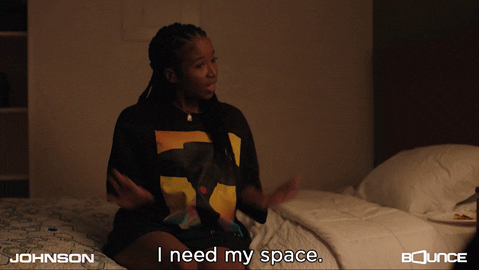 Giphy
GiphyA friend of mine recently bought a new house and invited me over to come see it. He’s a single man with no children, so as I was taking in all of the space that he had, especially as I walked through his finished basement, I joked about relatives coming to live with him. “Hell no” and “absolutely not” were pretty much his immediate responses as he went on to say that some folks even had the nerve to be offended when he told them that he had no intentions on taking DNA in.
Ain’t it wild how people think that your stuff is their right? And yes, that brings me to my next point. Your home is your sanctuary space. If you want to host folks this year — cool. If not, ALSO COOL. Please don’t let folks (family included) guilt you into how they want you to act or even into what they would do if the shoe was on the other foot. You are not them — and as one of my favorite quotes states, “If two people were exactly alike, one of them would be unnecessary.” (A man by the name Larry Dixon said that.)
Hell, my friends? They know that I am good for sending them random things that they need or even want all throughout the year. Coming over to hang out at my pace, though. Uh-uh. Chalk it up to being a card-carrying member of the ambivert club yet I like keeping my living space personal — and I sleep like a baby, each and every night, for feeling that way.
Always remember that your space, your time, your resources, your energy and shoot, yourself period (including your relationship), are all things that are your own. You get to choose how, when and why you want to share them. The holiday season is certainly no exception.
Cultivate Some “You Two Only” Traditions
 Giphy
GiphyIt’s not uncommon for some couples to hit me up after the holiday season to “detox.” Sometimes it’s due to the financial drama (and sometimes trauma) that they experienced. Sometimes it’s because they allowed their relatives (especially in-laws) to get more into their personal business than they should’ve. More than anything, though, it tends to be because they didn’t get enough quality time together and so ended up feeling “disconnected.”
Please don’t let that happen. Listen, I’m not even a holidays kind of woman and yet, I will absolutely sit myself down with some hot chocolate and chocolate chip cookies to enjoy a Hallmark holiday film or two. Aside from the fact that most of them are lighthearted and sweet, I also like that they usually focus on couples loving on each other amidst all of the holiday beauty and ambiance — which is something that all couples should set aside some time to do.
Maybe it’s a vacation. Maybe it’s a staycation. Or maybe it’s my personal favorite, A SEXCATION. Whether it’s for a few days, the weekend or even overnight — don’t you let the holidays go by without setting aside time for you and your man to celebrate one another. Don’t you dare (check out “Are You Ready To Have Some Very Merry 'Christmas Sex'?”).
GET. SOME. REST.
 Giphy
GiphyI once read that 8 out of 10 people get stressed out over the holidays and 3 out of 10 lose sleep during to it — and when you’re stress-filled and sleep-deprived, that can absolutely lead to hypersensitivity, making mountains out of molehills and even not being in the mood for sex.
Your relationship can’t afford to go through any of this, so definitely make sure to prioritize rest. I don’t care how unrealistic it might seem during this time, sleep should never be seen as a luxury; it will always and forever be a great necessity.
That said, try to get no less than six hours of shut-eye in (check out “6 Fascinating Ways Sex And Sleep Definitely Go Hand In Hand”) and even ask your bae to take a nap with you sometimes (check out “Wanna Have Some Next-Level Sex? Take A Nap, Sis.”). Not only will sleep help to restore your mind, body and spirit but, when it’s with your partner, it’s an act of intimacy that can make you both feel super connected, even in the midst of what might feel like chaos.
___
Holiday season stress is real. Still, never give it the permission or power to throw your relationship off. Put you and your man first and let the holidays be what they are gonna be, chile.
Let’s make things inbox official! Sign up for the xoNecole newsletter for love, wellness, career, and exclusive content delivered straight to your inbox.
Featured image by Shutterstock
It’s probably been over the past 2-3 years that I’ve become hyper-focused when it comes to applying certain chemical exfoliants known as acids to my skin. Personally, I’ve come to really appreciate ones like mandelic acid and hyaluronic acid because they have a way of softening my skin, brightening it up and really evening out my complexion overall.
In fact, on my skin, they have been so effective that they have caused me to wonder what would happen if I applied some of them to my hair too — and boy, was it an experiment that paid off big time!
If, while on your continual journey to get the best out of your own tresses, you’d like to learn how to get them healthier than it’s ever been, I’ve got seven acids that are typically known for skin use that can be just as beneficial to your hair as well.
1. Salicylic Acid
When it comes to your skin, salicylic acid is beta-hydroxy acid that is great for your skin if you’re looking for something that will exfoliate it, clear out your pores and dissolve dead skin cells. In fact, this is why it’s an acid that is quite popular when it comes to treating acne.
Your hair will enjoy salicylic acid because, if you’re looking to remove product build-up, you want to soothe an itchy or irritated scalp or you’ve got some dandruff flakes that are totally driving you up the wall, salicylic acid has the ability to treat all of this. Either purchasing a shampoo that contains this ingredient or adding it to your favorite scalp scrub is probably the most effective way to get the most out of it.
Just make sure that if your scalp is sensitive or dry that you approach with caution. In these instances, it could end up irritating your scalp more than helping it out, so use a very little bit in the beginning to make sure that it vibes with you.
2. Lactic Acid
Lactic acid is an alpha hydroxy acid that can help to even out your skin tone as well as slow down the signs of aging. The properties in it help to do this by reducing hyperpigmentation and boosting collagen production in your skin as well as keeping it hydrated.
Why is it great for your locks? For one thing, lactic acid is considered to be a humectant. This means that it pulls water from the air so that your hair is able to remain moisturized.
Another thing that makes it a winner is the fact that lactic acid breaks down dead skin cells on your scalp (so that your hair follicles are able to flourish), it can help to soften and detangle your hair (making it a helpful addition on your wash days) and it also helps to protect your tresses from heat styling tools and UV damage. Applying a hair rinse that’s made up of part lactic acid and part water can work wonderfully (so long as you apply it once a month, tops; more than that might be too “intense” for your hair strands).
3. Glycolic Acid
Glycolic acid is a water-soluble alpha hydroxy acid that is actually made from sugar. Your skin will adore it because it smooths the appearance of fine lines and wrinkles, improves the texture of your skin, gently exfoliates, clears your pores and brightens up your complexion overall.
The reasons why you should consider this acid for your hair is because it helps to keep your scalp youthful (and yes, there is such a thing; check out “Your Scalp Ages Six Times Faster Than Your Face. Why It Matters.”), removes excess sebum (that could be clogging up your hair follicles) and it helps to keep your hair moisturized. Your best bet here is to make it a part of your pre-shampooing ritual.
4. Succinic Acid
Succinic acid is an acid that is made from sugar cane and contains antimicrobial and anti-inflammatory properties. Although it doesn’t exactly exfoliate (like many of these other acids do), it can still be beneficial to your skin when it comes to reducing the kind of irritation that is associated with eczema, decreasing the bacteria that leads to breakouts and keeping your skin pretty hydrated.
As far as your hair goes, this is an acid that is worth trying out because it helps to balance the sebum that is on your scalp, remove dead skin and product build-up that can irritate your scalp and clog your hair follicles and, succinic acid is also beneficial when it comes to reducing dandruff and helping to prevent hair loss. Most people tend to apply this as a serum.
5. Hyaluronic Acid
I’ve officially sung the praises of hyaluronic acid on this platform before. One example is via the article, “Why Your Skin, Hair, And Nails Need Hyaluronic Acid Like...Yesterday.” On the skin tip, hyaluronic acid is great because it deeply hydrates your skin, contains anti-aging properties and can even bring relief to vaginal (including vulvar) dryness.
Your hair will adore this particular acid because it aids moisture to it (including your hair follicles), will help to improve your hair’s texture and it also soothes scalp dryness, nurtures the cuticles of your tresses and decreases frizz. Using a serum rich in this acid as a pre-poo or as a leave-in conditioner is recommended.
6. Azelaic Acid
If you’ve never heard of azelaic acid before, this is your lucky day. It’s a dicarboxylic acid that, when it comes to skincare (and hair care) products, is usually synthetic. Anyway, if you are looking for a way to reduce inflammation, even skin tone after a breakout or if you want to use an exfoliant that will improve the texture of your skin overtime, you might want to give this acid a shot.
This one makes the list as far as your hair is concerned because, if achieving more inches is your current focus, azelaic acid might come in handy. That’s because it is able to strengthen your hair, thicken your strands and also stimulate hair growth from within your hair follicles.
7. Glutamic Acid
Glutamic acid is actually a type of amino acid. Skin-wise, it’s great for deeply hydrating your skin as well as protecting it from pollutants and damaging UV rays. Also, if you’re looking for an acid that treats skin dryness or “tightness,” this could be the answer to your prayers.
Since glutamic acid is also considered to be a humectant, it’s another acid that can moisturize your hair. As a result, it can decrease breakage while helping your hair to feel smooth and look shiny.
BONUS: Amino Acids
Speaking of amino acids and hair, please try to keep some amino acids in your diet at all times. The reason why is because, since your hair is made up of mostly protein (keratin, to be exact), amino acids are pretty darn effective when it comes to helping you to maintain the overall health and well-being of your hair.
Ones to prioritize include proline (it boosts collagen so that your hair strands can maintain flexibility); arginine (it increases blood flow to your hair follicles so that they can receive the nutrients that they need); cysteine (it helps to keep your hair follicles healthy); alanine (it helps your system to produce more collagen), and isoleucine (it strengthens the tissues that help to make up your hair strands). All of these are available in supplement form or you can use Google to see which foods contain them.
___
Although it might initially seem odd to apply acid to your hair, as you can see, certain ones will work miracles for it. So, test them out to see which one tickles your fancy.
Hell, since they work for your skin as well — it’s a two-for-one deal that is worth every penny!
Let’s make things inbox official! Sign up for the xoNecole newsletter for love, wellness, career, and exclusive content delivered straight to your inbox.
Featured image by Shutterstock


